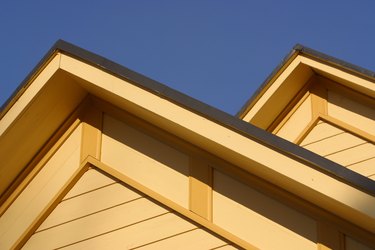
Deciding to undertake building projects in and around the home requires some mechanical knowledge. For instance, determining whether roof trusses need support in the center entails numerous considerations, rather than a simple answer. Some trusses contain central support while others lack it. Factors affecting the need for central support include the size and type of truss used in a construction project. All trusses are basically triangular in shape, though some contain curved elements.
Trusses
Video of the Day
Trusses provide weight distribution for numerous systems, including roofs and floors. Roof trusses, used with pitched roofs, relieve stress placed on a roof by the weight of its own material. They do this by distributing that weight down a series of lines designed to disperse load-bearing stress. Typically triangular in shape, trusses assume various forms depending upon their intended purpose, though all rely on the basic weight distribution principle of the arch: dispersing weight in numerous directions to relieve extreme stress centered in a handful of locations.
Video of the Day
Truss Design
The term "roof truss" constitutes a generic catchall referring to the two dozen or so types of trusses used in roofs. Nearly all types of trusses used in roofs, from kingpost and queenpost to bowstring and cambered, possess a central support beam. Some roof truss types, such as stub and dual pitch, contain no center and therefore lack central support. Though few roof truss designs lack central support, these designs, such as attic, fink and fan, appear commonly in pitched-roof homes and other domestic buildings, like sheds and garages.
Truss Dimensions
Truss dimensions affect the need for central support. Truss designs like attic exhibit relative uniformity in the lengths of the legs of the truss triangle. These types of triangles possess enough structural integrity to support weight without the need for a central support beam. Elongated trusses exhibit less structural integrity in the frame itself and therefore require numerous support beams to alleviate stress placed on the unit. Central support beams in elongated trusses, such as the modified queenpost, relieve load-being stress placed on the pinnacle, or top point, of the unit. These beams also provide extra support for the beams on either side of the truss.
Central Support
Determining whether you need central support for a roof truss ultimately comes down to why you need roof trusses. Most trusses used in domestic settings, such as homes and barns, experience relatively little stress unless you use very few trusses in areas with heavy snowfall. Generally, you don't need central support for domestic trusses. In industrial applications, trusses support enormous roofs made from heavy materials and thus generally require central support. You can use various math formulas, available online or in textbooks, to determine the exact weight strain placed on trusses and the type of truss you need to bear this load. Alternatively, contact a local contractor or carpenter for advice. When it doubt, always add additional support to prevent the risk of collapse.